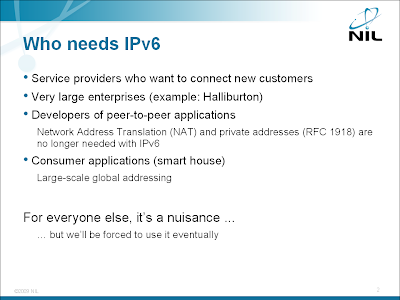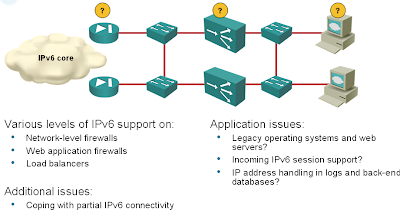Category: IPv6
Dual-stack PPP requires two separate sessions?
A while ago a senior Service Provider network designer told me that they have serious issues with IPv6 deployment as IPv6 requires a separate PPPoE session from the CPE devices which significantly increases their licensing costs. The statement really surprised me; PPP was designed to be a multi-protocol environment and it’s very easy to configure IPv4 and IPv6 over a single PPP session in Cisco IOS. I think I might have tracked down the source of this “information” to the 6deploy IPv6 and DSL presentation which states on Page 11 that “Separate PPP sessions are established between the Subscriber’s systems (or CPE) and the BBRAS for IPv6 and IPv4 traffic”.
Being too Cisco-centric, I cannot figure out whether this claim has any merit, as it clearly does not apply to Cisco IOS. Are there really boxes out there that are so stupid that they cannot run two protocols across a single PPPoE session?
Who Needs IPv6?
One of the most common questions asked by my enterprise customers is “Who needs IPv6?” Since IPv6 does not add any significant new functionality (apart from larger address space), you can’t gain much by deploying it in an enterprise network … unless you’re huge enough that the private IPv4 address space (RFC 1918) becomes too confining for you. A good case study is Halliburton; you’ll find the details in Global IPv6 Strategies: From Business Analysis to Operational Planning book (my review).

IPv6 in the Data Center: is Cisco ready?
With the recent Cisco’s push into the Data Center environment and all the (not so very unreasonable) fuss around IPv4 address depletion and imminent need for IPv6, I wanted to check whether an all-Cisco shop could do the first step: deploy IPv6 on Internet-facing production servers. If you follow the various design guidelines, your setup will have at least the following elements (and I bet someone from Cisco has already told you that you also need XML firewall, Ironport and WAAS appliance):
Now let’s see how well these boxes support IPv6.
I’m describing the Data Center IPv6 deployment issues in the Enterprise IPv6 Deployment workshop. The diagram above was taken straight from the workshop materials.
ITU: Grabbing a Piece of the IPv6 Pie?
ITU (the organization formerly known as CCITT) is having a bit of a relevance problem these days: its flagship technological achievements, including X.25, ISDN, ATM, and SDH, are dead or headed toward oblivion … and a former pariah, a group of geeks, is stealing the show and rolling out the Internet. No wonder their bureaucrats are having a hard time figuring out how to justify their existence. For years they’ve been lamenting how much they’ve contributed to the Internet (highly recommended reading for Monty Python fans) and how their precious contributions were unacknowledged. Now they came forth with a “wonderful” idea: the history of IPv4 address allocation proves that the wealthy nations and early adopters managed to grab disproportionate parts of the IPv4 address space (well, that’s true), so they made it their mission to protect the poor and underdeveloped countries in the brave new IPv6 world. In short, they want to become an independent address allocation entity (RIR). It looks like another worldwide bureaucracy is precisely what we need on top of all the other problems we have with IPv6 deployment.
IPv6-capable or IPv6-ready: is it enough?
During the IPv6 summit in Slovenia I’ve participated in a roundtable organized by our Ministry of Higher Education, Science and Technology. One of my points was that the government should require true IPv6 support in all its IT procurement processes to promote IPv6 adoption (I have to admit I’ve borrowed a few ideas from Geoff Huston’s “Is the Transition to IPv6 a Market Failure?” article) … and one of the participants (coming from the Service Provider industry) answered that “that’s common hygiene”. I’m not so sure.
Topics like this are covered in my Enterprise IPv6 Deployment workshop. Learn more about my workshops from my web site.
Deploying IPv6 in Enterprise Networks
I was invited to present my views on the IPv6 deployment in enterprise networks during the local IPv6 summit. Instead of joining the cheering few or the dubious crowds, I’m trying to present a realistic view answering questions like “what do I have to do”, “when should I start” and “where should I focus my efforts”.
Here’s the outline of my presentation, any feedback, additional thoughts or insightful critique is most welcome.
What Went Wrong: TCP/IP Lacks a Session Layer
One of the biggest challenges facing the Internet core today is the explosion of the IP routing and forwarding tables, which is caused primarily by traffic engineering and multihoming requirements. Things were supposed to get better when IPv6 introduced strict hierarchical addressing (similar to the phone number addressing, where the first few digits always denote the country code).
Unfortunately, the hierarchical IPv6 addressing idea relied on incredible belief that the world will shape itself according to the wills of the IETF working group members. Not surprisingly, that didn’t happen and the hierarchical IPv6 addressing idea was quietly scrapped, giving us plenty more prefixes to play with when trying to pollute the global IPv6 routing tables.
Published on , commented on March 10, 2023
Lack of IPv6 Multihoming: the Elephant in the Room?
I have to admit I have no hands-on Service Provider IPv6 experience (but then there are not too many people that can claim they do) and I don’t attend RIPE meetings, so I might have a completely wrong impression, but here it is: Is it just my perception or do we really lack any production-grade means of end-user multihoming in IPv6?
Book review: IPv6 Security
The high-end books published by Cisco Press are usually pretty good, but every now and then they manage to produce a masterpiece that has all the potential to become a legend. The “IPv6 Security” book by Scott Hogg and Eric Vyncke is definitely in this category and is a must-read for anyone who plans to deploy IPv6 in the future (that should include around 100% of the network engineers).
How obscure can it get?: BGP IPv6 printouts
If you want to display any IPV6-related BGP objects (neighbors, routes …) you can use the familiar BGP commands, but have to prefix them with show ip bgp ipv6 unicast. For example, to display the BGP neighbors active in the IPv6 address family, you would use show ip bgp ipv6 unicast summary command. I doubt you like so much typing (I don't, just entering the IPv6 addresses is enough for me); luckily Cisco IOS has aliases - just configure alias exec bgpv6 show ip bgp ipv6 unicast and (for consistency) alias exec bgpv4 show ip bgp ipv4 unicast.
Update 2010-03-12: Cisco IOS also supports show bgp ipv6 unicast command, which (at least) makes BGP ipv4-agnostic.
Global IPv6 strategies
If you want to understand the buzz raised recently about IP version 6, and your daily job includes more budget meetings, payroll discussions or strategy/operational planning than router configuration, Global IPv6 Strategies: From Business Analysis to Operational Planning (Cisco Press, 2008) is a mandatory book for you. The authors, Patrick Grossetete, Ciprian P. Popoviciu and Fred Wettling, are weathered veterans of the IPv6 battles, and their lengthy experience with IPv6 shines through the pages of this book.
Display operational IPv6 interfaces
PE-A#show ipv6 interface brief | section up
Serial1/0 [up/up]
unassigned
Serial1/1 [up/up]
FE80::C800:CFF:FEA7:0
Loopback0 [up/up]
unassigned
The definition of the associated follow-up lines depends on the printout. Usually the indented lines are assumed to belong to a section, but you might be surprised.
OSPFv3 Router ID: the Long Shadow of IPv4
One of the obscure facts about IPv6 OSPF (OSPFv3) is that it uses a 32-bit router ID like OSPFv2. It’s a reasonable choice; I have yet to see an OSPF network with over a billion routers. However, could you guess how this requirement is implemented in Cisco IOS? OSPFv3 searches for an IPv4 address (effectively the same algorithm used by OSPFv2) to get the router ID for the IPv6 routing process. Neat, isn’t it?
You might wonder what happens if you want to configure an IPv6-only router. OSPF won’t start unless you configure the router ID manually. And, no, you cannot enter a number (which would be the expected format, as the router ID is just a number in the IPv6 world); you have to enter an IPv4 address. Long live IPv4 :))
Router Fragmentation Is Gone from IPv6
In response to my Never-Ending Story of IP Fragmentation, Stojanco Cavdarov made an interesting observation: routers are not allowed to fragment IPv6 packets, they have to respond back with ICMP unreachable (effectively, routers behave as if IPv6 packets would have an implicit don't fragment bit).
To make life easier for non-TCP IPv6 applications (TCP is supposed to use Path MTU Discovery), the minimum IPv6 packet size that has to be supported on all links was increased to 1280 bytes (which, incidentally, fits very nicely into GRE+IPSec envelope transported across links with 1500-byte MTU).
IPv6 Deployment: Time for Action?
A while ago I was asked to write an article about IPv6 training. I could just cover the training aspect, like what’s offered (answer: not much) and whether someone can train the whole operations team like you could in the IPv4 or MPLS/VPN world (answer: no), but I wanted to understand whether anyone is really using IPv6 in a production network.
I found a few academic networks (after all, there are about 2000 IPv6 prefixes assigned and someone should be doing something with them), but not much of what I would call a real production environment, which is a bad thing, as it looks like the IPv4 address space will get saturated in a few years.

